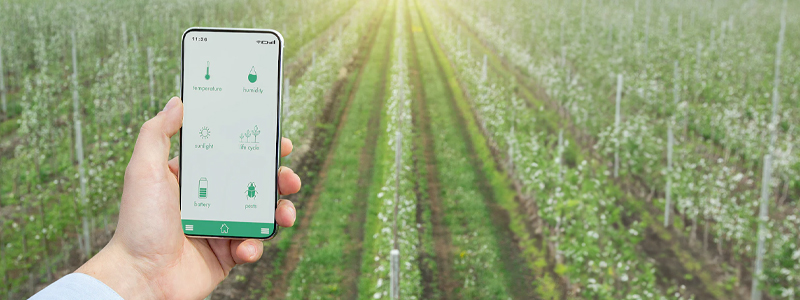"Artificial intelligence is the electricity of the 21st century." - Andrew Ng.
"Artificial intelligence is the new electricity; it has the potential to transform every industry and every aspect of human life." - Sundar Pichai.[1]
Nowadays, Artificial Intelligence is a key term used in most areas. Agricultural industry is not an exception. Food security is a major threat to the globe due to a variety of reasons like climatic changes, increasing population, water scarcity, land degradation, reduction in biodiversity, etc. Addressing these challenges and ensuring food security through collaborative efforts is the need of the hour.
Farmers use manual methods for farming, livestock management, soil and water management, crop disease prediction, pest detection, etc. With the advent of AI, agricultural activities are undergoing a massive shift. The integration of AI technologies brings about noteworthy advancements in various aspects of farming, revolutionizing traditional practices. Here are some remarkable changes and benefits brought by AI in agriculture:
With advancements in agriculture, more changes can be noticed in terms of efficiency and sustainability. AI acts as facilitator to achieve sustainable agriculture by optimizing usage of natural resources thereby reducing environmental impacts. By implementing precise irrigation practices, targeted nutrient supply and efficient disease and pest management practices through AI, water resources are conserved, chemical usage minimized, and environment-friendly farming practices are promoted.
AI can be integrated with IOT (Internet of Things) technology, where sensors detect environmental conditions, soil moisture level, detect crop diseases, etc. Farmers can gain valuable insights which help them to manage their farms and ensure most favorable growth conditions.

Let’s look into a general timeline with reference to development and adoption of AI technologies in agriculture varying across different regions and farming practices.
1. Early Adoption (Pre-2010)
AI applications in agriculture before 2010 were primarily focused on basic data analysis and decision support systems, with limited advancements.
2. Data Collection and Analytics (2010-2015)
From 2010 onward, agriculture saw a growing emphasis on data collection and analytics, leveraging AI techniques like machine learning to analyze agricultural data encompassing weather patterns, soil conditions, and crop yields. These insights empowered farmers to make better-informed decisions concerning planting, irrigation, and crop management.
3. Robotics and Automation (2010-2015)
During this period, robotics and automation gained momentum in agriculture, with the development of AI-powered robots designed for various tasks like harvesting, seeding, and crop monitoring. These robots were equipped with sensors and computer vision systems to accurately detect and execute precise actions in the field.
4. Precision Agriculture (2015-2020)
Precision agriculture emerged as a significant application of AI in farming, utilizing technologies like remote sensing, drones, and satellite imagery. These AI tools enabled real-time data collection on crop health, soil moisture, and nutrient levels. Machine learning algorithms were then employed to analyze this data, providing actionable insights to optimize crop production, minimize resource waste, and mitigate environmental impact.
5. Crop Disease Detection (2015-2020)
AI algorithms were created to enable early detection of crop diseases and pests. These algorithms employed computer vision techniques to analyze images of plants, identifying indications of diseases or infestations. Early detection of diseases empowered farmers to implement preventive measures, leading to reduced crop losses and a decrease in the need for excessive pesticide use.
6. Smart Irrigation Systems (2015-present)
The emergence of AI-powered smart irrigation systems revolutionized water management in agriculture by enabling precise control. These systems utilized real-time data, such as weather conditions, soil moisture levels, and crop water requirements, to optimize irrigation schedules. As a result, water waste was minimized, and irrigation practices were fine-tuned for optimal efficiency.
7. Plant Phenotyping and Breeding (2015-present)
AI technologies have found application in plant phenotyping and breeding, where computer vision algorithms and machine learning models analyze various plant traits like leaf shape, size, and color. These analyses aid in the selection of the most desirable characteristics for breeding purposes and facilitating the development of improved crop varieties.
8. Farm Management Systems (2015-present)
AI-based farm management systems have been developed to integrate diverse aspects of agriculture. These systems gather and integrate data from various sources, including weather forecasts, soil data, and machinery performance. By combining this information, they provide comprehensive insights and decision support to farmers, helping them make informed choices and optimize their agricultural operations.
9. Future Developments:
Artificial intelligence (AI) is swiftly changing the agricultural industry. New AI-powered technologies, such as robots, self-driving vehicles, and predictive analytics, are being developed to automate farming practices, optimize yields, and reduce environmental impact. The potential benefits of AI in agriculture are noteworthy. AI-powered technologies can aid in improving crop produce, decrease food wastage, and make farming more sustainable. As AI continues to evolve, it is likely to play an even greater role in the future of agriculture and many thanks to the technology for making it possible in the near future!
Reference(s):
-
https://www.cnbc.com/2018/02/01/google-ceo-sundar-pichai-ai-is-more-important-than-fire-electricity.html
About the Author
Mrs. Sowmiya is an accomplished computer science professor with a decade of teaching experience. Currently, she is pursuing her doctoral research in Digital Image Processing, specializing in machine learning and deep learning. Her contributions include published papers in esteemed platforms like ICT academy and Scopus indexed journals. As a firm believer in lifelong learning, she cherishes the idea that the mind can never exhaust its capacity for knowledge.